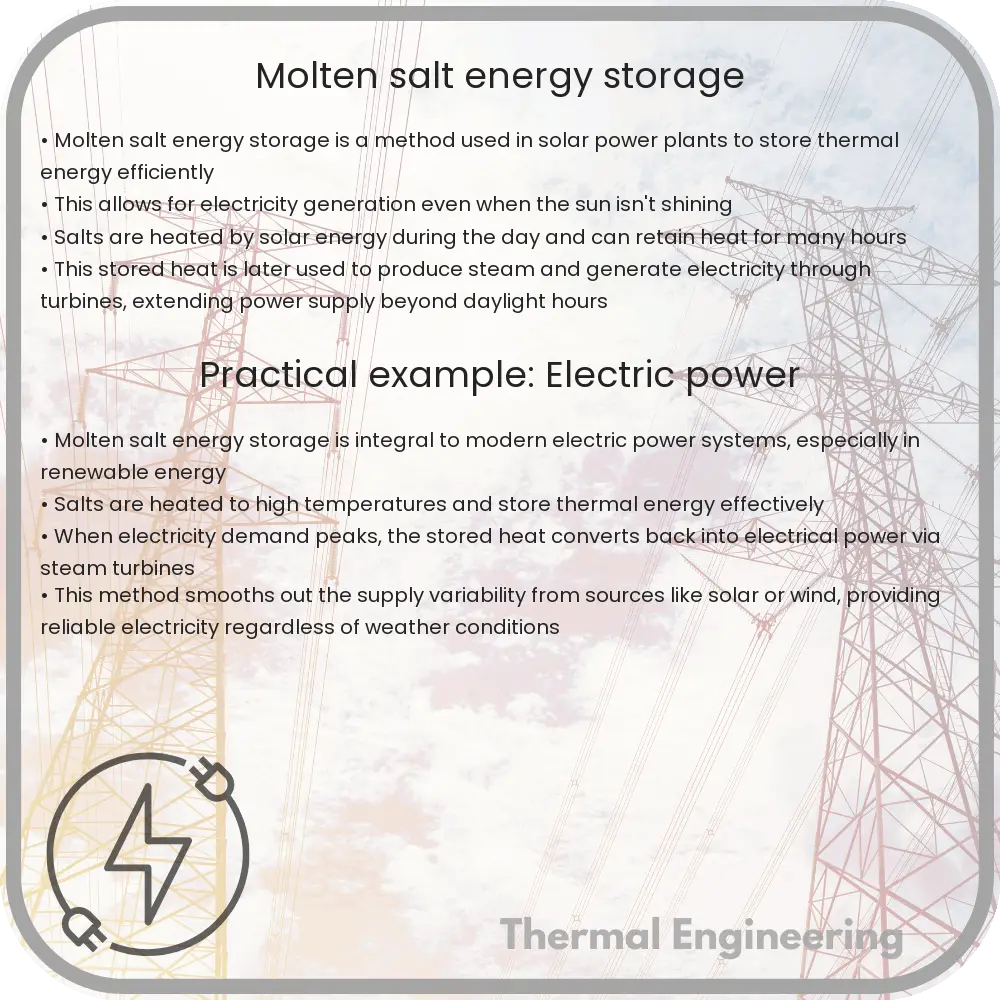Learn about molten salt energy storage, a key technology for enhancing renewable energy efficiency by storing heat for consistent power supply.

Molten Salt Energy Storage: An Overview
Molten salt energy storage, particularly utilized in the field of solar power generation, offers a significant advantage in managing energy supply by storing excess heat for later use. This technology is crucial for enhancing the efficiency and reliability of renewable energy sources, which are inherently intermittent due to their dependence on weather conditions.
How it Works
The basic principle of molten salt energy storage involves the absorption and storage of energy in the form of heat. Salts are heated to a molten state using surplus energy generated during peak sunlight hours. This molten salt, usually consisting of a eutectic mixture of sodium nitrate and potassium nitrate, can reach temperatures of up to 600°C. The high boiling point of these salts allows them to store large amounts of thermal energy effectively and at relatively low cost.
Components and Process
The system primarily includes a solar receiver, thermal storage tanks, and steam generators. During operation, molten salts are pumped through the solar receiver, where they are heated by concentrated solar power. The hot salts are then stored in an insulated tank. When energy generation is needed (for example, during the night or on cloudy days), the stored hot salt is transferred to a heat exchanger to produce steam. This steam drives a turbine, generating electricity much like conventional steam power plants.
Benefits of Molten Salt Energy Storage
- Increased Efficiency: By storing excess heat, these systems can smooth out the variations in solar power availability, providing a steady, reliable power output regardless of sunlight conditions.
- Cost-Effectiveness: Molten salts are relatively inexpensive and abundant, and their capability to store heat for up to several hours reduces the need for expensive, fast-reacting power reserves.
- Scalability: Systems can be designed for varying scales, from small, distributed systems to large, central station facilities.
- Environmental Impact: This technology supports the increased penetration of renewable energy sources, reducing reliance on fossil fuels and lowering greenhouse gas emissions.
Challenges Faced
- Corrosion: High operating temperatures and the corrosive nature of molten salts can degrade materials used in storage tanks and piping systems over time.
- Energy Conversion Efficiency: The process of converting stored heat back to electricity usually has a round-trip efficiency of 30-40%, implying a significant loss of stored energy.
- Initial Capital Cost: Despite the low cost of salts, the initial setup cost for molten salt energy storage systems is high, especially for large-scale implementations.
Future Prospects
The ongoing development of advanced materials that are more resistant to high temperatures and corrosion could alleviate some of the current challenges, increasing the system’s efficiency and lifespan. Research into alternative salts with lower melting points and better thermal properties is also under way. Moreover, integrating molten salt storage with other renewable energy sources such as wind or geothermal systems might enhance the versatility and efficiency of energy storage technology as a whole.
In conclusion, molten salt energy storage stands out as a promising solution for overcoming the limitation of intermittent renewable energy sources, offering a pathway towards more consistent and reliable green energy systems.